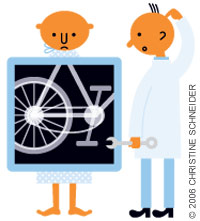
“If X then Y” rarely works when you're dealing with patients.
Fam Pract Manag. 2006;13(10):74
Dr. Wenner is associate director of the University of Minnesota/St. Cloud Hospital Family Medicine Residency in St. Cloud, Minn. Author disclosure: nothing to disclose.

"I should have been a bicycle mechanic,” I muttered as I sized up the day unfolding before me. Manual labor, a finite task and dirty fingernails actually sounded appealing as I realized that my carefully mapped-out course for the day was being detoured by overbooking, a green medical student and a primip falling way off Friedman's curve.
After a busy week in practice, absent-minded tinkering has a cathartic effect. It clears my mind and allows it to operate more efficiently. In computerspeak, it's called “defragmentation.” Some practice yoga, listen to classical music or faithfully visit the gym. Those less adept at stress management may kick the dog. I tinker with bicycles.
Bicycles have evolved into highly complex machines, yet they maintain an elegant simplicity. The pedals go “round ‘n’ round,” which moves the chain, which turns the wheel, which propels the bicycle forward. If a pedal is broken, it needs replacing. If the chain is rusty, it needs lube. If a wheel is bent, it needs to be trued. If X then Y.
The human body can also be viewed in very straightforward fashion. Air moves “in and out”; blood goes “round ‘n’ round.” Yet patients are not so simple and not so amenable to algorithms.
While treatment or diagnostic algorithms can aid us in the practice of medicine, they are but a part of caring for patients. Each patient visit requires active cognition and complex decision making. It also requires establishing a connection with the patient, which can arguably be the most difficult part of practicing medicine. Medical schools do a good job of selecting those able to “make the connection,” but it is up to practicing physicians to cultivate and nurture this skill in ourselves and in our colleagues with less experience.
As medical knowledge expands rapidly, new modalities are being developed to help us incorporate it into everyday practice. But the practice of medicine will always require cognition and relationship-building, both of which are optimized through longitudinal care. In fact, longitudinal care may be the most valuable therapeutic and diagnostic tool available to physicians and patients, if they're willing to invest in it.
Viewing patients as bicycles (or algorithms or RVUs) leads to suboptimal care and patient dissatisfaction. On the converse, giving patients our full attention and investing in that relationship for the long term leads to high-quality care and patient satisfaction. It is also more satisfying for physicians.
I guess I will leave my tinkering for the garage.